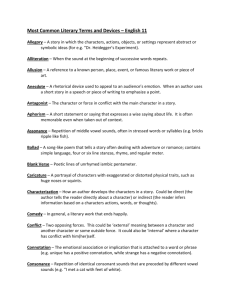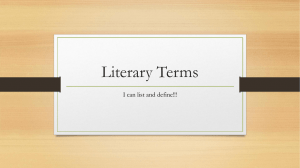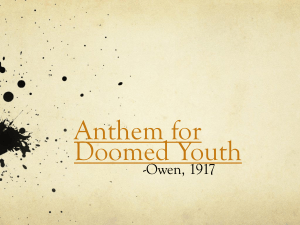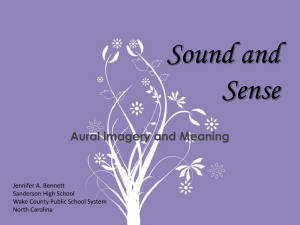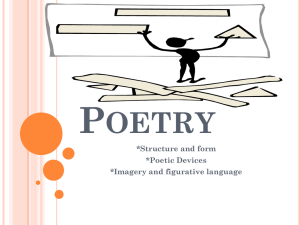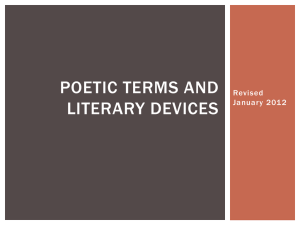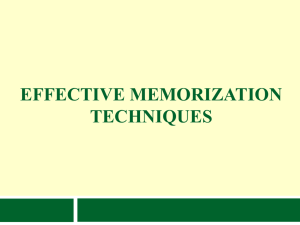Example - San Juan
advertisement
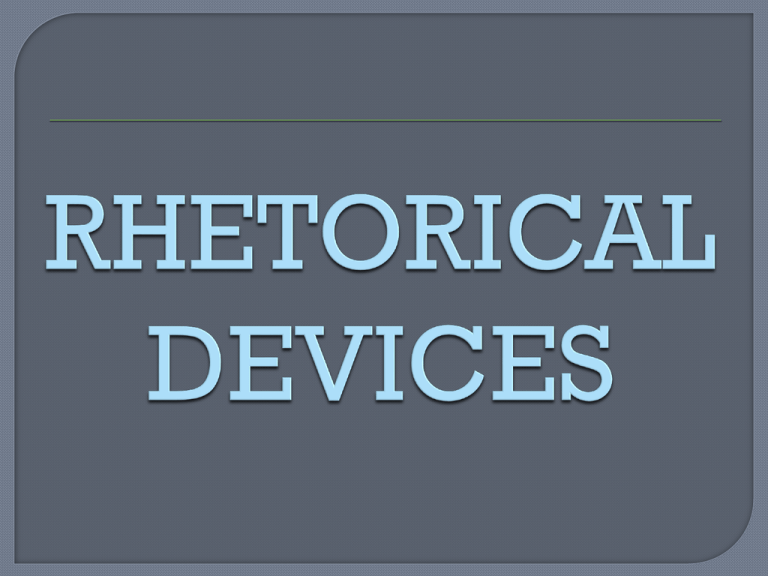
The repetition of initial identical consonant sounds or any vowel sounds in successive or closely associated syllables, especially stressed syllables. Example 1: The slithery snake slipped through the slippery grass Example 2: Ay, that incestuous, that adulterate beast, With witchcraft of his wits, with traitorous gifts Purpose: The repetition may imitate the sound of what is talked about, as in Example 1. However, often the connection is much more subtle and creates a mood or rhythm to influence the reader, much like background music in a movie. Repetition of both the s sound and the t sound accent the intensity of the statement. The repetition of a word or phrase at the beginning of successive phrases, clauses, or lines. Example: “We shall not flag or fail. We shall to on to the end. We shall fight in France, we shall fight on the seas and oceans, we shall fight with growing confidence and growing strength in the air, we shall defend our island, whatever the cost may be.” Winston Churchill Purpose: The repetition creates a rhythm that can build to a crescendo. The technique is often used by politicians and preachers to raise the emotional level of their audience. Repetition also makes the ideas easier to remember. A figure of speech in which someone (usually but not always absent), some abstract quality, or a nonexistent personage is directly addresses as though present. Example 1: Busy old fool, unruly sun, Why dost though thus, Example 2: Papa Above! Regard a Mouse. Purpose: Apostrophe is used to express deep emotions. The speaker often challenges or pleads to something abstract and unchangeable or a higher power. Instead of saying, “The sun woke me up” the poet addresses the sun and is able to directly communicate his displeasure, as in Example 1. Same or similar vowel sounds in stressed syllables that end with different consonant sounds. (Rhyme has the same or similar vowel sounds and ending consonant sounds.) Example: The bows glided down, and the coast Blackened with birds took a last look At his thrashing hair and whale-blue eye; The trodden town ran its cobbles for luck. Purpose: Repeating vowels sounds is much more difficult to “hear” than alliteration. However, the effect is similar: the repetition adds to the musical quality of the poem, accenting mood and meaning. The above example forces the reader to open the inside of his/her mouth to create the repeated vowel sounds ow and oo. The effect slows the tempo, adds melancholy tone and accents the contemplation of the moment. A strong pause within a line of verse. Example: He thought he’d ‘list, perhaps, Off-hand-like—just as I— Was out of work-had sold his traps— No other reason why. Purpose: The caesura in the middle two lines of the above quote is identified by the dash at the end of the line, indicating a longer pause than normal. It can signify a pause in the thought process of the narrator or a slight change in the direction of the poem and forces the reader to pause to consider, too. A pattern in which the second part is balance against the first but with the parts reversed. Example 1: “Flowers are lovely, love is flowerlike.” Example 2: “Ask not what your country can do for you, but what you can do for your country.” Purpose: As in the second example by President Kennedy, the chiasmus creates an easily remembered and understood clause. Also, like antithesis, it emphasizes the comparison between the two objects or ideas presented. The emotional implications and associations that words may carry, as distinguished from their denotative meanings. Connotation depends on usage in a particular linguistic community and climate. A purely private and personal connotation cannot be communicated; the connotation must be shared to be intelligible to others. Example: Bob sees Sally’s horrendous hair and says, “Nice haircut.” Purpose: An author or poet carefully chooses words to have the correct connotations so the correct tone and attitude will be communicated. For example, if the author wants the reader to have a negative impression of a character he might describe the character as “grotesquely obese”. If he wanted the reader to be more compassionate, he might describe the character as “pleasantly plump”. The basic meaning of a word, independent of its emotional colorations or associations; the dictionary meaning of a word. Example: epiphany – any sudden and important manifestation or realization Purpose: The purpose is fairly self-explanatory. However, realize that a poet or author is very sensitive to both the denotation(s) and connotation(s) of words and may intend the meaning of more than one definition. When you analyze, keep a dictionary handy. In linguistics it means “word choice”. Often it refers to both vocabulary (plain or fancy, current or archaic, native or foreign, etc.) and syntax (arrangement of words; simple or complex, complete or fragmentary, loose or periodic, etc.). Example: Whose woods these are I think I know [simple vocabulary but complex syntax] Purpose: The purpose of diction caries greatly by usage. A complex symbol where every part contains significance. An “emblem” consisted of a motto expressing a moral idea and was accompanied by a picture and a short poem. Example: The motto Divesque Miserque, “both rich and poor,” illustrated by a picture of King Midas sitting at a table where everything was gold and by a verse explaining how Midas, though rich, could not eat his gold. In poetry, Donne uses emblems like the compass or the bubble. Purpose: Emblems add depth to the poem. It allows the reader to delve deeply into the meaning of the poem and still derive substance from the symbol. A run-on line of poetry in which logical and grammatical sense carries over from one line into the next. An enjambed line differs from an end-stopped line in which the grammatical and logical sense is completed within the line. In the opening lines of Robert Browning’s “My Last Duchess,” for example, the first line is endstopped and the second enjambed. Example: That’s my last Duchess painted on the wall, Looking as if she were alive. I call That piece a wonder, now …. Purpose: When a line ends, the reader’s mind continues in a train of thought. By ending the line at a particular point, the reader may be expecting a particular idea. The poet can then subtly communicate two messages: the one the reader expects and the one that the next line clarifies. Both are intended and the contrast between them should be explored. Exaggeration. Example: No; this my hand will rather The multitudinous seas incarnadine [to dye flesh colored or crimson], Making the green one red. Purpose: May be used to heighten effect, or it may be used for humor. An analogy identifying one object with another and ascribing to the first object one or more of the qualities of the second. Metaphor is similar to SIMILE but creates a stronger connection between the objects being compared. Example: The iron clouds threatened rain. Purpose: See simile. Metaphors can have a stronger, farther reaching effect than similes. An allegory may be considered an elaborate metaphor where the original object is never mentioned. Pilgrim’s Progress creates an allegory of Christian life by using such places as the Swamp of Despair. A figure of speech in which a closely related term is substituted for an object or idea. See Synecdoche. Example: “We have always remained loyal to the crown.” Purpose: Be aware of how metonymy (or synecdoche) may distance the reader from a more specific or complete idea and draw attention to a slightly different concept. In the above example, if “king” was used instead, the loyalty would apply more directly to the person of the king rather than the office. A self-contradictory combination of words. Example: Bittersweet, jumbo shrimp, military intelligence. Purpose: Oxymorons tend to emphasize duality, that a person can feel two things at once or an object can be two things at the same time. For example, when Romeo, still love-sick over Rosaline, stumbles across the remnants of a brawl he declares: Why, then, O brawling love! O loving hate! O anything of nothing first create! O heavy lightness! Serious vanity! Romeo’s declaration expresses not only his own inner turmoil at having his love unrequited, but also foreshadows the violence to come because of his love for Juliet. The use of words to imitate the sounds they describe. Example: When Ajax strives some rock’s vast weight to throw, The line too labors, and the words move slow. Most often, however, onomatopoeia refers to words and groups of words, such as Tennyson’s description of the “murmur of innumerable bees,” which attempts to capture the sound of a swarm of bees buzzing. Obviously, this device overlaps with assonance and alliteration. A figure that endows animals, ideas, abstractions, and inanimate objects with human form; the representing of imaginary creatures or things as having human personalities, intelligence, and emotions. Example: Keats described a Grecian urn as a, “Sylvan historian, who canst this express/ A flowery tale more sweetly than our rhyme.” Purpose: Personification adds power and interest. It also allows then poet or author to engage more directly with the thing they are talking about. For example, in “The Sun Rising,” Donne speaks directly to the sun (apostrophe) and endows the sun with human characteristics. Since Donne’s argument is presented directly to the sun as a rational entity, there is a much more dynamic “discussion” than if he were talking to an inanimate object. Most simply, the ending vowel and succeeding consonants of two or more words sound the same. There are a great variety of rhymes (end, internal, masculine, feminine, triple, true, identical rhyme) which can be used. Example: eternity, symmetry Purpose: Often times the rhymed words interrelate. Especially in free verse poetry, take special note of rhyming words; they are meant to be compared and contrasted. Rhyming words may also provide emphasis of a particular point. The pattern in which rhyme sounds occur in a stanza. Every word that has the same rhyme receives the same letter of the alphabet. Example: My mistress’ eyes are nothing like the sun; Coral is far more red than her lips’ red; If snow be white, why then her breasts are dun; If hairs be wires, black wires grow on her head. A B A B Purpose: Especially in sonnets, the rhyme scheme will accent the development of the poem. As in the above portion of Shakespeare’s sonnet #130, the four lines contain a complete thought and the rhyme scheme compliments it. The next eight lines are divided likewise, and the couplet at the end accents the “punch line” or main point. When rhyme scheme appears, even in vague forms, pay close attention. Directly expresses similarity between two objects using “like,” “as,” or “than.” Example: A dungeon horrible, on all sides round. As one great furnace flamed . . . [The connection between dungeon (Hell) and the furnace is directly expressed using “as.”] Purpose: Comparing two unlike things does two things. First, it allows the reader a frame of reference, something s/he can relate to in order to describe something unfamiliar. Second, the choice of the comparison object can be highly connotative and influential in the reader’s perception. Compare, “Her lips were as red as apples.” and “Her lips were as red as blood.” A figure of speech in which a part is substituted for the whole. See Metonymy. Example: “Lend me a hand.” Purpose: Often synecdoche, like the above example, is an idiom. However, within a poem, it can place emphasis on a particular detail to develop a theme or idea. In some poems, synecdoche may help establish a theme or fragmentation.
